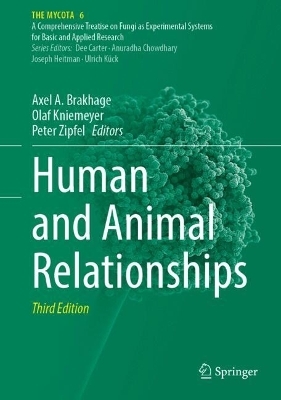
Human and Animal Relationships
Springer International Publishing (Verlag)
978-3-031-64852-6 (ISBN)
- Noch nicht erschienen - erscheint am 30.12.2024
- Versandkostenfrei innerhalb Deutschlands
- Auch auf Rechnung
- Verfügbarkeit in der Filiale vor Ort prüfen
- Artikel merken
Estimates based on sequencing data suggest that there are around 5.1 million species of fungi. Yet only a small number of fungi are harmful to animals, including humans. In addition to host-pathogen interactions, there are also mutualistic interactions between fungi and animals. Diseases caused by pathogenic fungi range from allergic reactions and superficial infections to invasive mycoses, and have a significant impact on human and animal life. Fungi are also cultivated by animals as a food source in highly developed relationships or are even involved in gut mutualism.
This 3rd edition of Volume 6 of The Mycota highlights exemplary interactions between fungal pathogens and their host(s). The book is organized in three parts:
- Part 1 summarizes our current understanding of important pathogenic fungi such as Candida species, Malassezia yeasts, Aspergillus fumigatus and fungi of the order Mucorales.
- Part 2 addresses the characterization of the host response towards pathogenic fungi. It focuses on RNA as a mediator of host-pathogen interactions, the human gut mycobiome, the role of the innate immune system in fighting infections, pattern recognition receptors involved in fungal infections, and a summary of established infection models for studying host-fungal-pathogen interactions.
- Part 3 provides insights into the impact transcriptomics and proteomics technologies have on the research of human-pathogenic fungi.
The up-to-date reviews by experts in the field provide the reader with a comprehensive overview of the various research topics in the field of human and animal relationships with fungi and will hopefully help researchers to find inspiration for their own research.
Axel A. Brakhage earned a Master's degree in Biology with the major subject Microbiology at the University of Münster. During his PhD he spent a year at the Institut de Biologie Physico-Chimique in Paris. After obtaining a PhD on the regulation of the phenylalanyl-tRNA synthetase in Bacillus subtilis, he joined the Biotechnology Department of BASF as a staff scientist. He then started work on the molecular biology of filamentous fungi as a postdoctoral student at the University of Sheffield (UK). After two years, he became an Assistant Professor at the Institute of Genetics and Microbiology at the University of Munich where he earned his habilitation in Microbiology. In 1998 he became Associate Professor at the Darmstadt University of Technology. During 2001-2004 he was chair and Full Professor of Microbiology at the University of Hanover. From 2004 he has held a chair of Microbiology and Molecular Biology at the Friedrich Schiller University of Jena. In 2005 he became head of the Department of Molecular and Applied Microbiology at the Leibniz Institute of Natural Product Research and Infection Biology - Hans-Knoell-Institute (Leibniz-HKI) - in Jena and, simultaneously, he serves as the Director of the Institute. He is a member of several scientific boards and a Vice President of the Deutsche Forschungsgemeinschaft. In addition, he is Speaker of the DFG Collaborative Research Centre/Transregio 124 "FungiNet", was founding speaker of the cluster of excellence "Balance of the Microverse" and serves on the editorial boards of several journals. He has received the Seeliger-Award for Bacteriology and Mycology (2006) and the Main Research Award of the German Society for Hygiene und Microbiology (DGHM). In addition, he is elected member of the German Academy of Sciences Leopoldina and of both the American and European Academy of Microbiology. His research addresses two main areas: (1) pathobiology of the most important airborne fungal pathogen Aspergillus fumigatus. (2) molecular regulation of the biosynthesis of fungal secondary metabolites with emphasis on microbial communication and shaping of microbiomes.
Olaf Kniemeyer studied biology with the major subject Microbiology at the University of Bremen. He completed his Master thesis (Diplom) about anaerobic cholesterol degradation in 1998.
He performed his dissertation and a short postdoctoral time under the supervision of Friedrich Widdel at the Max Planck Institute for Terrestrial Microbiology in Bremen in the field of anaerobic hydrocarbon degradation. After a short stay as visiting scientist at the University of Sheffield (UK) in the lab of Geoffrey Turner he joined the laboratory of Axel A. Brakhage at the Leibniz University of Hanover in 2003. Since 2005, he is scientific co-worker at the Leibniz Institute for Natural Product Research and Infection Biology - Hans-Knoell-Institute (HKI) in Jena and since 2009 Deputy Head of the Department of Molecular and Applied Microbiology of Axel Brakhage. His work focuses on the application of proteomics methods to study the human-pathogenic fungus Aspergillus fumigatus and other Aspergilli. Olaf Kniemeyer serves on the editorial board of several journals and has received funding for his research from funding agencies such as DFG, GIF and BMBF.
Peter F. Zipfel studied Biology and Biochemistry with specialization in Cellular Biology. In 1984 he graduated from the University in Bremen. He performed his postdoctoral studies at the Laboratory of Immunoregulation at the NIAID, National Institutes of Health in Bethesda (Md., USA). Then he moved to the Bernhard Nocht Institute for Tropical Medicine in Hamburg where he headed a junior research group. He received his Habilitation and venia legendi from the University of Hamburg in 1993 in the areas of Immunology and Genetics. In 2000 he was appointed Uni
Part I. Pathogens.- Chapter 1. Trinity of Environment, Animals, and Humans: A Résumé in the Case of the Fungal Order Mucorales.- Chapter 2. Pathogenicity Strategies of Candida Species During Interaction with Epithelial Cells.- Chapter 3. Malassezia Yeasts in Animals in the Next-Generation Sequencing Era.- Chapter 4. Extracellular Proteins and Their Roles in Aspergillus Fumigatus Pathogenesis.- Part II. Host-Pathogen Interaction.- Chapter 5. RNA as a Mediator of Host-Fungal Pathogenesis.- Chapter 6. The Human Gut Mycobiome and Its Potential as a Regulator of the Host's Metabolic Health.- Chapter 7. The Host Innate Immune Response to Pathogenic Candida Albicans and Other Fungal Pathogens.- Chapter 8. Mammalian Pattern Recognition Receptors (Prrs) Involved in Recognition of Fungi.- Chapter 9. Infection Models for Human Pathogenic Fungi.- Part III. Techniques.- Chapter 10. Transcriptomic Analyses of Host Colonisation in Fungal Pathogens of Humans.- Chapter 11. Proteomics and Its Application to the Human-Pathogenic Fungus Aspergillus Fumigatus.
| Erscheint lt. Verlag | 30.12.2024 |
|---|---|
| Reihe/Serie | The Mycota |
| Zusatzinfo | XVIII, 275 p. 38 illus., 36 illus. in color. |
| Verlagsort | Cham |
| Sprache | englisch |
| Maße | 178 x 254 mm |
| Themenwelt | Naturwissenschaften ► Biologie ► Mikrobiologie / Immunologie |
| Naturwissenschaften ► Biologie ► Mykologie | |
| Schlagworte | Aspergillus • Candida • Fungal-Host Interaction • Fungal Infections • Fungi • host response • immunology • Infections • mycobiome • Mycology • Mycosis • pathogenic fungi • Termites |
| ISBN-10 | 3-031-64852-8 / 3031648528 |
| ISBN-13 | 978-3-031-64852-6 / 9783031648526 |
| Zustand | Neuware |
| Haben Sie eine Frage zum Produkt? |
aus dem Bereich


